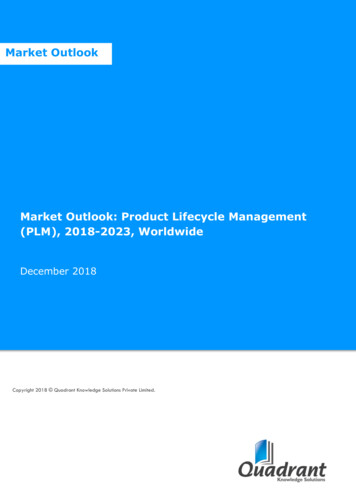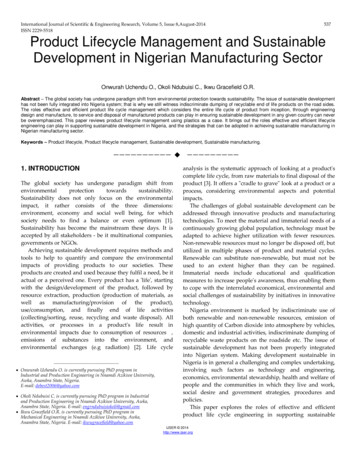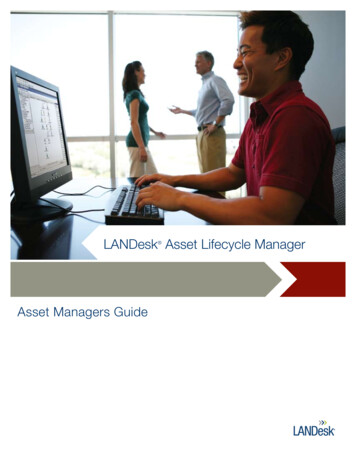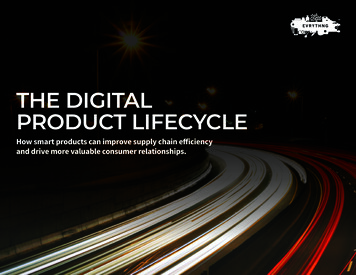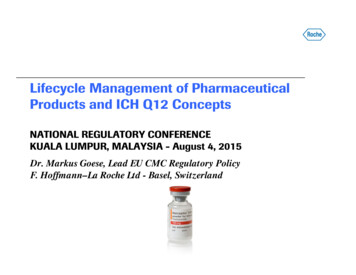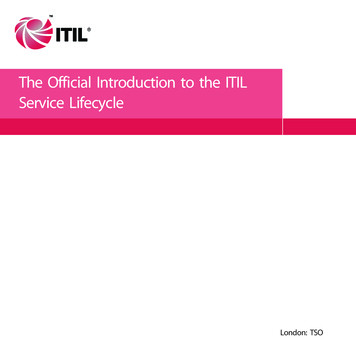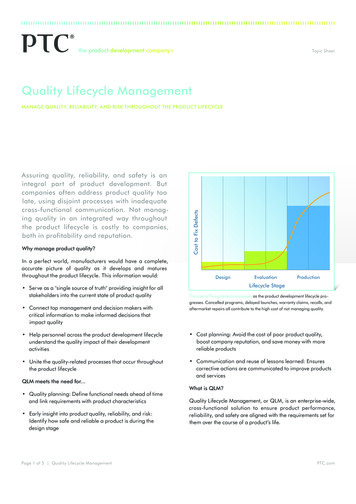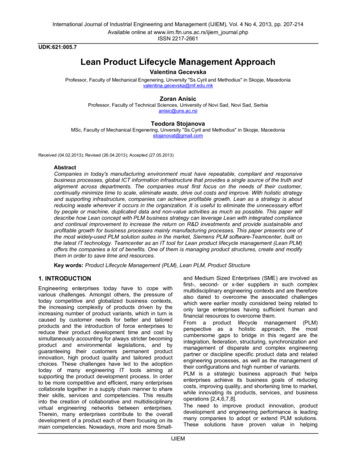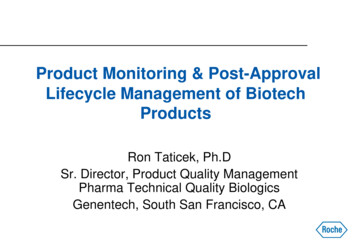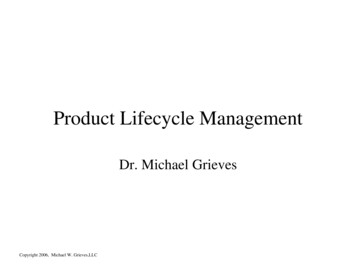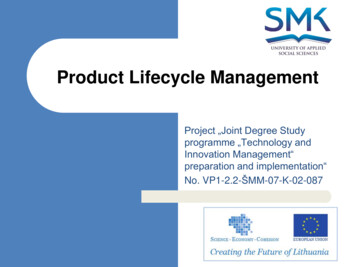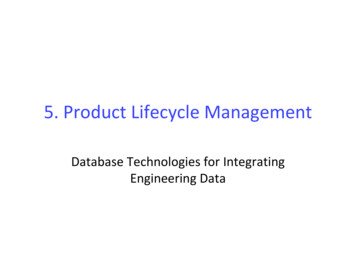
Transcription
5. Product Lifecycle ManagementDatabase Technologies for IntegratingEngineering Data
Overview Motivation––– Overview of Product Lifecycle Management–– History: From Engineering Databases to PLM SystemsRelation to CAD and Enterprise Ressource Planning (ERP)Functionality–––––– The Product LifecycleThe Product Development ProcessIslands of AutomationProduct Data ManagementProduct Structure ManagementDocument ManagementEngineering Workflows: Projects, Workflows and State ManagementVersions, Variants, ConfigurationsUser ManagementPLM System ProductsPLM and STEPSchallehn: Data Management for Engineering Applications
Term: Product Lifecycle ManagementProduct Lifecycle Management (PLM) comprises concepts to manageproducts and integrate all according product data over their entirelifespan from inception to disposal. Strategic management concept Includes methods, processes and organizational principles Supported by specific software: PLM SystemsA Product Lifecycle Management System (PLM System) is a softwaresystem that enables and supports Product Lifecycle Management byintegrating data and metadata from systems involved in all life phases ofa product, and, based on this, provide higher-level functionality.Schallehn: Data Management for Engineering Applications
ProductLifeCycleSchallehn: Data Management for Engineering ApplicationsFrom [2]
Usage in Product Development Not limited to usage by engineers Historically stemming from “Engineering Databases” Still focused on product development processSchallehn: Data Management for Engineering Applications
Product Development ProcessSchallehn: Data Management for Engineering ApplicationsFrom [2]
History of PLM Systems Engineering Databases (EDB): software systems to manage and integrateengineering data Engineering Data Management (EDM): EDB concepts to structureengineering processes Product Data Management (PDM): EDM Integration of non-engineeringproduct data (e.g. marketing, sales, etc.) Product Lifecycle Management (PLM): PDM focus on integratedmanagement conceptsFrom [2]Schallehn: Data Management for Engineering Applications
Historical Landscape: Engineering DataSchallehn: Data Management for Engineering ApplicationsFrom [2]
Other Related Terms Historical or alternative related terms–––––Technical Information SystemTechnical Drawing Management SystemEngineering Document Management SystemProduct Information Management Schallehn: Data Management for Engineering Applications
PLM Integration Concepts Development from EDB to current PLM systems triggered byso-called “islands of automation”– Many software specialized systems used in engineering– Input for one system may be generated by another system– All have their own storage concepts and formats PLM systems try to manage integrated Product Model (alsoProduct Information Model, Product Data Model, ProductData Record, etc.)– All partial data/models connected through metadata– Metadata stored in database system– Actual data maybe controlled by PLM system in special vaults (maybestored in the database as BLOBs)Schallehn: Data Management for Engineering Applications
Exchange between “Islands of Automation”From [2]Schallehn: Data Management for Engineering Applications
PLM and other Systems PLM and CAD Systems– CAD Systems have central role in product development– Output (geometrical data of solid designs) often input for manyfurther systems– Very tightly integrated with PLM systems PLM and Enterprise Resource Planning (ERP)– ERP systems represent integrative perspective from operativemanagement– Overlapping/not clearly separated from PLM, e.g. production planningtightly linked with product data– PLM and ERP considered along with Customer RelationshipManagement and Supply Chain Management as cornerstones ofcompany data management– E.g. SAP PLM is part of SAP Business Suite along with SAP ERPSchallehn: Data Management for Engineering Applications
Central Role of CADFrom [2]Schallehn: Data Management for Engineering Applications
PLM and ERPFrom [2]Schallehn: Data Management for Engineering Applications
PLM Systems Architecture Typically– More or less separated modules providing basic functionality Product data/product structure managementDocument managementProcess/workflow management – Database to store Metadata of product data Optional: product data as BLOBs or in Database File System Information about users, projects, processes– Interfaces to many systems providing relevant product data– Collaboration synchronized by DBMSSchallehn: Data Management for Engineering Applications
PLM System ArchitectureSchallehn: Data Management for Engineering ApplicationsFrom [2]
PLM Main Functionality Product Structure Management: construction of products fromparts or assemblies - input for production planning and Bill ofMaterial (BOM) Document Management: control of storage for engineering data Product Data Management: references and relationshipsbetween partial product information from various engineeringsystems Process Management: representation and support for execution ofengineering workflows Configuration and Version Management: management of changesand states of product data User Management: management of engineers, their roles, andcollaboration in processesFrom [2]Schallehn: Data Management for Engineering Applications
PLM Main FunctionalityFrom [2]Schallehn: Data Management for Engineering Applications
Product Structure Management Hierarchical/tree-like structure Product as root of tree Assemblies as inner nodes consisting of other assemblies or parts Parts (produced within company or bought from supplier) as leafnodes Central role in data management Product data and documents are linked to parts in tree Alternatives represented in tree are subject to configurationmanagement Bill of Materials (BOM) can be created from product structureSchallehn: Data Management for Engineering Applications
Example: Product StructureFrom [1]Schallehn: Data Management for Engineering Applications
Example: Product Structure SchemaSchallehn: Data Management for Engineering Applications[Li Chen, Tingjin Wang and Zhijie Song : AWeb-based Product Structure Manager toSupport Collaborative Assembly Modeling]
Bill of Materials (BOM) Special form of representation of the productstructure data May contain varying information depending onusage in– Engineering– Manufacturing– Sales Configurable BOMs can be applied for configurationmanagementSchallehn: Data Management for Engineering Applications
BOM ExampleFrom [1]Schallehn: Data Management for Engineering Applications
Document Management Strong requirements and regulations regarding themanagement of engineering documents– Legal regulations to store product data for certain timespan– ISO 15226:1999 Technical product documentation -- Lifecycle model and allocation of documents N:M Relation to product data and product structure– There may be many documents on one part (e.g. design,specification, simulation, electronic components, etc.)– There may be documents related to many parts/products(e.g. specification of product line or parameterizabledesign)From [3]Schallehn: Data Management for Engineering Applications
Document Management /2Schallehn: Data Management for Engineering ApplicationsFrom [3]
Document Management /3 Document Structure: similar to product structure– Document may contain other documents N:M-relation to files– Document may consist of several files– Same file may be contained in many documents Vault: Controlled storage location– Special area in file system (special control mechanismsaccess right, distribution, etc.)– BLOB in relational databaseSchallehn: Data Management for Engineering ApplicationsFrom [3]
Document Management /4Schallehn: Data Management for Engineering ApplicationsFrom [3]
Variants, Version, Configurations Management of versions and variants keyfunctionality of PLM systems– Sequence of version– Branches of Alternatives Combined with hierarchical product structurebecome configuration management (CM) Configuration state of a complex product Tightly integrated with process/worflow modelSchallehn: Data Management for Engineering Applications
PLM Systems Enovia (Dassault Systems)TeamCenter (Siemens)Windchill (Parametric Technology Corporation)Oracle Agile Engineering (Oracle)SAP PLM (SAP)Schallehn: Data Management for Engineering Applications
PLM Systems: ENOVIASchallehn:Managementfor Engineering Applications[U. Brachtet al., DataDigitaleFabrik,Springer 2011]
PLM Systems: SiemensSchallehn: Data Management for Engineering Applications[U. Bracht et al., Digitale Fabrik,Springer 2011]
PLM Systems: Siemens TeamCenterFrom [3]Schallehn: Data Management for Engineering Applications
PLM Systems:Oracle AgilePLMBOM BrowserFrom [3]Schallehn: Data Management for Engineering Applications
PLM and STEP STEP does not define a single dedicated workpackage to support PLM systems Relevant protocols AP 203: Configuration controlled 3D design(mainly for CAD) AP 214: Core data for automotive mechanical designprocesses (mainly for CAD) AP 212: Electrotechnical design and installation (ECAD,EDA) AP 232: Technical Data Packaging Core Information andExchange (exchange and archiving)Schallehn: Data Management for Engineering Applications
PDM Schema Initiave (by ProStep)[ProSTEP: Usage Guide for the STEPPDM Schema V1.2 Release 4.3, 2002]Schallehn: Data Management for Engineering Applications
PLM and STEP /2 Some recently developed APs address more holisticview of engineering activities AP 233: Systems Engineering data representation(added PLM relevant concepts in 2012) AP 239: Product Lifecycle support (focused on phasesafter product development ) AP 242: Managed model based 3D engineering (merges203 and 214 some PDM functionality)Schallehn: Data Management for Engineering Applications
STEP AP 233 (Systems Engineering)Schallehn: Data Management for Engineering Applications[Top-level schema from STEP AP233]
STEP AP 239Schallehn: Data Management for Engineering Applications[Overview of Usage, from STEP AP239]
STEPAP 242[Package overview fromSTEP AP 242]Schallehn: Data Management for Engineering Applications
Combined Usage of relevant APsSchallehn: Data Management for Engineering Applications[from http://www.ap242.org/]
STEP Modular Architecture Numerous overlapping and redundant definitionsacross APs are problematic Recently addressed by decomposed and combinableAPs of AP4xx and AP1xxx series, e.g.– AP439 is reworked version of AP239– Consists of several atomic building blocks Part 1287 – AP239 activity recordingPart 1297 – AP239 document managementPart 1289 – AP239 management resource informationPart 1293 – AP239 part definition informationPart 1304 – AP239 product status recording Schallehn: Data Management for Engineering Applications
Literature / Further Readings[1]John Stark: Product Lifecycle Management - 21st Century Paradigmfor Product Realisation.ISBN: 978-0-85729-545-3 , Springer 2013[2]Hirz Mario, Wilhelm Dietrich, Anton Gfrerrer, Johann Lang:Integrated Computer-Aided Design in Automotive Development.ISBN: 978-3-642-11939-2, Springer 2013[3]Martin Eigner, Ralph Stelzer: Product Lifecycle Management - EinLeitfaden für Product Development und Life Cycle Management.ISBN: 978-3-540-44373-5, Springer 2009Schallehn: Data Management for Engineering Applications
A Product Lifecycle Management System (PLM System) is a software system that enables and supports Product Lifecycle Management by integrating data and metadata from systems involved in all life phases of a product
